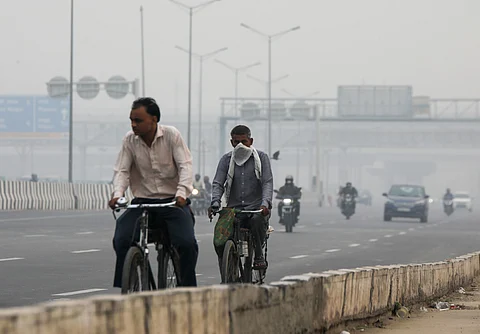

The headline and the article have been updated for clarity
A new analysis by Delhi-based think tank Centre for Science and Environment (CSE) revealed that ground-level ozone breached national safety limits on nearly every day in the National Capital Region (NCR) between March and May 2025, with wider geographical spread and longer durations than seen in previous years.
Out of 18 days between May 25 and June 11, ozone was the lead pollutant on 12 days in the city’s official Air Quality Index (AQI), displacing fine particulate matter (PM2.5) for the first time over such a sustained period. Despite this, the current emergency response framework, the Graded Response Action Plan (GRAP), contains no provisions for curbing ozone or its precursor gases, CSE pointed out in a press note on June 17, 2025.
“There is no system to address this problem under GRAP to reduce exposure or to address its sustained mitigation with a long-term clean air action plan,” said Anumita Roychowdhury, executive director at CSE. “If unchecked, this can become a serious public health crisis, as ozone is a highly reactive gas.”
Delhi recorded exceedances of the eight-hour ozone standard on all 92 summer days, the CSE report showed. Neighbouring cities in the NCR crossed the limit on 83 days. Nehru Nagar in South Delhi was the worst affected, with ozone levels breaching safe limits every day, while Sector 125 in Noida and Vasundhara in Ghaziabad reported the highest number of exceedance days outside the national capital.
Unlike PM2.5, which is directly emitted, ozone forms through chemical reactions involving nitrogen oxides, volatile organic compounds and carbon monoxide in the presence of sunlight. These gases come from vehicles, power plants, industries and other combustion sources. Hot days, particularly during summer and heat waves, tend to have higher ozone levels. Heat and sunlight accelerate the chemical reactions that produce ground-level ozone.
The analysis showed that ozone levels not only rose during the day but often remained elevated late into the night. On average, stations in Delhi recorded ozone levels above the standard for 14.2 hours a day — up from 12 hours last summer. In NCR towns, this figure rose to 15 hours. Gwal Pahari in Gurugram logged the highest number of night-time ozone events.
The peak reading this summer came from the CRRI Mathura Road station in Delhi, which recorded an eight-hour average of 472 micrograms per cubic metre (µg/m³) on May 19 — more than four times the national standard. In previous years, such high values went unreported due to a 200 µg/m³ cap, which was not enforced this year.
The study also found that ozone hotspots tended to occur in areas with low levels of NO₂ and PM2.5, since ozone breaks down more quickly in polluted zones with high NOx. Wazirpur and Loni in Ghaziabad were notable exceptions, showing high levels of all three pollutants, indicating complex local dynamics.
Sharanjeet Kaur, deputy programme manager at CSE’s Urban Lab, highlighted the importance of capturing high levels of localised exposures in the hotspots adequately and to design mitigation strategies accordingly. “Managing short term exposures is critical to protect public health,” she stated.
As per the United States’ Environment Protection Agency, even relatively low levels of ozone can cause health effects. It can irritate and harm the airways, make the lungs more susceptible to infection and worsen lung diseases like asthma, emphysema and chronic bronchitis.
CSE urged policymakers to urgently integrate ozone and its precursors into the clean air framework. This includes revising the GRAP and strengthening long-term measures to promote zero-emissions vehicles, cleaner industrial fuel use and full remediation of waste burning.
“Ground-level ozone gets created in polluted areas but drifts and accumulates in cleaner urban environments, urban peripheries and surrounding rural areas affecting agricultural productivity and food security,” CSE stated. “It requires effective control at both local and regional levels.”